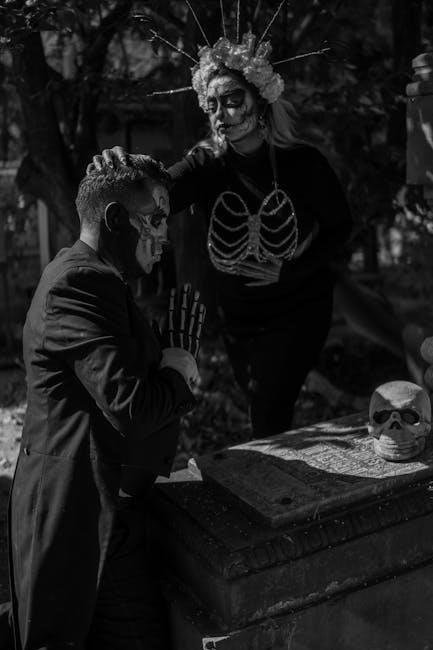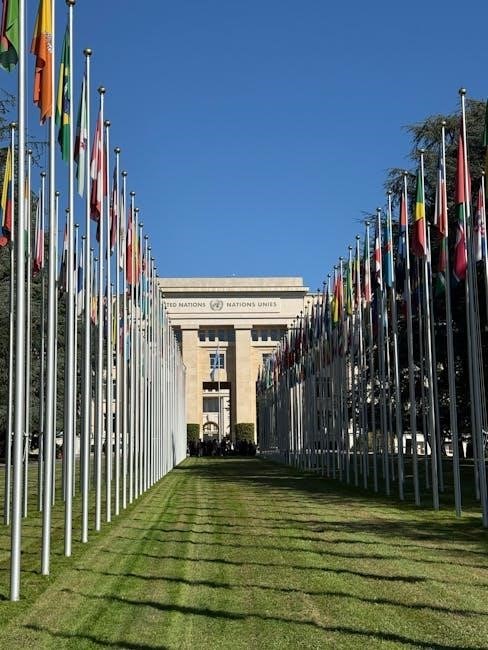Title: “Chronicle of a Death Foretold” by Gabriel García Márquez
Chronicle of a Death Foretold, a novella by Gabriel García Márquez, published in 1981, blends journalism and fiction to recount the tragic fate of Santiago Nasar.

Background of the Book
Chronicle of a Death Foretold, published in 1981, is a novella blending journalism and fiction, recounting a tragic murder in a small Colombian town, exploring fate and honor.
2.1. Publication and Reception
Chronicle of a Death Foretold was published in 1981 by Editorial La Oveja Negra in Bogotá. The novella received widespread acclaim for its unique blend of journalism and fiction, exploring themes of fate and honor. It was praised for its concise yet powerful narrative style, which captivated readers worldwide. The book solidified García Márquez’s reputation as a master of magical realism and remains one of his most celebrated works, included in lists of the greatest novels of the 20th century.
2.2. Historical Context
Chronicle of a Death Foretold is set in a small Colombian town, reflecting the cultural and social dynamics of Latin America in the mid-20th century. The novella explores themes of honor, tradition, and fate, deeply rooted in the region’s history. García Márquez draws from real-life inspirations, blending factual events with fictional elements. The story critiques societal norms, such as the rigid expectations of masculinity and the role of the church, offering a poignant commentary on the era’s moral landscape.
2.3. Gabriel García Márquez’s Literary Style
Gabriel García Márquez’s literary style in Chronicle of a Death Foretold is a masterful blend of magical realism and journalistic narrative. His prose is rich, vivid, and lyrical, creating a dreamlike atmosphere while grounding the story in a tangible reality. The non-linear structure and use of fate as a central theme reflect his unique ability to weave the extraordinary with the mundane. This style captivates readers, immersing them in the tragic inevitability of Santiago Nasar’s destiny.

Plot Summary
Chronicle of a Death Foretold recounts the tragic murder of Santiago Nasar, a young man killed by the Vicario brothers to restore family honor, foretold yet unavoidable.

3.1. The Tragic Fate of Santiago Nasar

Santiago Nasar’s death is foretold through ominous prophecies and warnings, yet the townspeople fail to prevent it. The novel reconstructs his final days, revealing his unawareness of the danger. His murder, carried out by the Vicario brothers to restore family honor, shocks the community. The narrator’s reconstruction of events highlights the inevitability of Santiago’s fate, blending journalistic detail with fictional storytelling to create a haunting tale of destiny and tragedy.
3.2. The Role of the Vicario Brothers
The Vicario brothers, driven by a misguided sense of honor, seek to avenge their sister’s alleged dishonor. Their actions are fueled by societal expectations and a rigid moral code. Despite warnings, they commit the murder, believing it their duty. The novel explores their motivations, revealing a tragic interplay of honor, shame, and violence that shapes the story’s outcome and underscores the destructive nature of societal norms.
3.3. The Prophecies and Omens
The novella is woven with prophecies and omens that foretell Santiago Nasar’s death. The townspeople sense the impending tragedy, yet no one intervenes. The narrative underscores the inevitability of fate, as the Vicario brothers’ actions align with the foretold events. This interplay of destiny and free will creates a haunting atmosphere, emphasizing the inexorable march toward the tragic conclusion.

Themes Explored in the Novel
Fate and destiny, honor and shame, and love and betrayal are central themes, intertwined to explore human nature and societal norms in a tragic narrative.
4.1. Fate and Destiny
The novel explores the inevitability of fate through Santiago Nasar’s doomed destiny, emphasized by recurring omens and prophecies. The townspeople’s awareness of the impending tragedy underscores the inescapable nature of fate. García Márquez masterfully intertwines fate with human actions, suggesting that destiny is both predetermined and shaped by choices. This theme is central to the narrative, highlighting the futility of resisting the inevitable and the profound impact of fate on human lives and societal expectations.
4.2. Honor and Shame
Honor and shame are pivotal themes, driving the novel’s tragic events. The Vicario brothers’ quest to restore family honor through Santiago Nasar’s murder highlights the rigid societal norms governing reputation and morality. García Márquez critiques the destructive power of honor, illustrating how it leads to violence and perpetuates cycles of vengeance; The novella portrays shame as a corrosive force, urging readers to reflect on the devastating consequences of prioritizing honor over humanity and compassion in a restrictive, tradition-bound society.
4.3. Love and Betrayal
Love and betrayal are central to the novella, as Angela Vicario’s rejection of Santiago Nasar due to her unrequited love for Bayardo San Román triggers the tragic events. The arranged marriage and Angela’s refusal to accept Santiago illustrate the destructive power of betrayal and the societal expectations governing love. García Márquez explores how doomed relationships and unfulfilled desires drive the characters toward their fate, emphasizing the devastating consequences of love turned to deceit and heartbreak in a rigid, traditional society.

Character Analysis
The novel focuses on Santiago Nasar, the doomed protagonist, the Vicario twins, his vengeful antagonists, and the narrator, who reconstructs the tragic events.
5.1; Santiago Nasar: The Protagonist
Santiago Nasar, a wealthy, charming bachelor, is the central figure of the novella. His doomed fate is sealed when the Vicario brothers vow to kill him for honor. The narrator reconstructs Santiago’s final days, revealing his privileged upbringing, cultural heritage, and the tragic inevitability of his death. Despite the prophecies and warnings, Santiago’s fate remains unaltered, symbolizing the inexorable force of destiny in a society bound by rigid moral codes and familial honor.
5.2. The Vicario Twins: The Antagonists
The Vicario twins, Pedro and Pablo, are driven by a misguided sense of honor to avenge their sister’s disgrace. Their actions are fueled by societal expectations and a rigid moral code. Despite their brutal act, the twins evoke both fear and pity, as their fate is intertwined with Santiago’s. The novella portrays them as tragic figures, highlighting the destructive consequences of unchecked honor and societal norms in a conservative community.
5.3. The Narrator: Unraveling the Mystery
The narrator serves as both investigator and storyteller, reconstructing the events leading to Santiago Nasar’s death through interviews and recollections. While the outcome is foretold, the narrator’s pursuit of details engages readers, blending journalistic inquiry with literary depth. The narrator’s voice reflects on the moral and cultural complexities, offering insights into the collective guilt and fate that bind the community. This dual role highlights the interplay between fact and fiction, as the narrator unravels the layers of truth behind the tragedy.

The Book’s Legacy
Chronicle of a Death Foretold has become a timeless classic, exploring fate, honor, and love. Its acclaim solidifies García Márquez’s mastery of magical realism, leaving a lasting literary legacy.

6.1. Critical Acclaim
Chronicle of a Death Foretold received widespread critical acclaim for its unique narrative style and profound exploration of fate, honor, and love. García Márquez’s magical realism captivated readers, blending the surreal with the mundane. The novella’s concise yet powerful storytelling solidified its place as a masterpiece of 20th-century literature, earning it a spot among the greatest works of magical realism and ensuring its enduring influence on global literary culture.
6.2. Cultural Impact
Chronicle of a Death Foretold has left a profound cultural impact, transcending literature to influence film, theater, and popular culture. Its exploration of fate, honor, and love resonates globally, making it a cornerstone of magical realism. The novella’s themes have sparked debates on societal norms and human destiny, while its concise storytelling has inspired adaptations worldwide, cementing its legacy as a cultural touchstone and a timeless reflection of human experience.
6.3. Adaptations and Interpretations
Chronicle of a Death Foretold has been adapted into films, plays, and operas, further amplifying its global reach. Its themes of fate and honor have inspired reinterpretations across cultures, with scholars exploring its symbolism and moral complexity. The novella’s concise narrative has also been analyzed through feminist and postcolonial lenses, offering diverse perspectives on its universal themes, making it a rich text for both entertainment and academic study, ensuring its enduring relevance in modern media and scholarship.

Resources for Readers
Resources for readers include the PDF version of Chronicle of a Death Foretold, available on platforms like Amazon and Google Books. Study guides and detailed analyses are also accessible online.
7.1. Where to Find the PDF Version
The PDF version of Chronicle of a Death Foretold can be found on platforms like Amazon, Google Books, and educational websites. Readers can also access it through libraries or purchase it directly from eBook stores. Ensure to use legitimate sources to download or view the PDF to respect copyright laws and support the author’s work.
7.2. Study Guides and Analysis
Study guides and detailed analyses of Chronicle of a Death Foretold are widely available online. Websites like Amazon, Google Books, and educational platforms offer companion books and essays. These resources provide insights into themes, characters, and García Márquez’s unique narrative style. Additionally, many universities and literary websites publish critical essays and study notes, helping readers deepen their understanding of the novella’s cultural and historical context.




